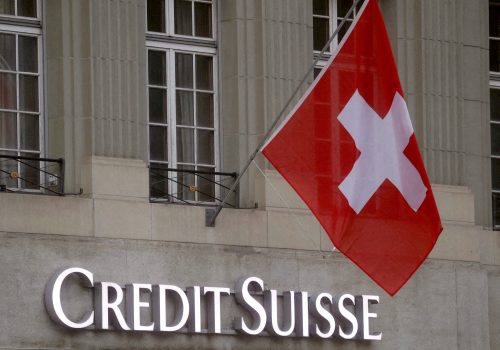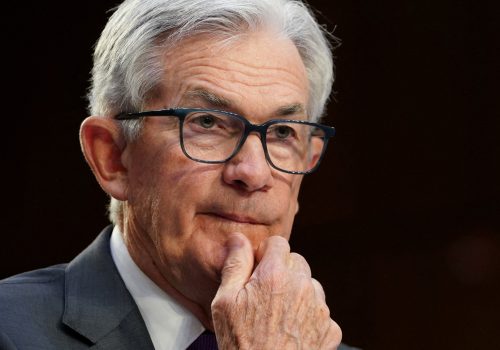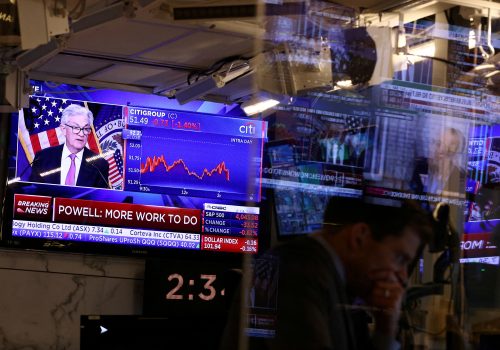Financialization has increased economic fragility
Since the 1980s, financial activities and assets have played an increasingly dominant role in the global economy. At the same time, underlying economic activity as measured by global GDP has been growing more slowly. The result has been an ever-larger gap between the volume and value of financial activity relative to the real economy. And that gap has left economies more susceptible to financial instability and crisis and more dependent on fiscal and monetary support from governments. Governments, however, are stretched thin—thanks to high debt and interest rates and outsized central bank balance sheets. Nonetheless, the pace of financial activity continues.
We are therefore in uncharted territory. The threat of financial crisis at a time when governments are ill-equipped to respond is probably the greatest risk currently facing the global economy.
Financial deregulation and innovation—growth interrupted by financial crises
The process of financialization started in the 1980s, influenced by the economic thoughts of, among others, Milton Friedman (laissez faire capitalism with minimal role of government) and Eugene Fama (maximizing shareholder value). Waves of financial deregulation were implemented in the United States (under Ronald Reagan) and the UK (under Margaret Thatcher), allowing banks and other financial institutions to engage in more activities and markets. Corporate managers were increasingly incentivized by stock options, to align their incentives with shareholders. Financial innovation flourished—with many new financial instruments, especially derivatives, which facilitated active trading and hedging by market participants.
Debt increased over the same period while the credit quality of both public and private borrowers steadily deteriorated, weakening their abilities to service those debts. For example, there are only two S&P rated corporations with an AAA rating now compared to sixty in 1980; and the United States is about to lose its AAA status. Of particular concern has been the pattern of volatile capital flows to emerging markets and low-income countries, leading to debt buildup and subsequent crises—disrupting and retarding their growth.
Financial deregulation and innovation were supposed to improve the allocation of capital, promoting economic growth—which did occur, albeit unevenly, over the past four decades. However, global economic growth has been slowing down from 4-5 percent in the post-war decades prior to the 1980s to 3 percent or less at present. Moreover, growth has been interrupted by financial crises, requiring increasing government intervention and support.
In the 1980s, financial activities contributed to a sustained bull market in the United States and elsewhere, leading to the Black Monday market crash on October 19, 1987—accentuated by the pro-cyclical nature of new portfolio insurance techniques. Then market enthusiasm over the internet spurred the dot-com market bubble which burst in 2000. Lower inflation during the so-called Great Moderation allowed central banks to be accommodative in their policies which together with new instruments like credit default swaps and collateralized mortgages/loans obligations contributed to the Great Financial Crisis (GFC) in 2008. The GFC forced major central banks (including the Fed, ECB, BoJ and PBOC) to inject a huge amount of liquidity into their economies through quantitative easing—ballooning the size of their balance sheets, from $5 trillion in 2007 to $20 trillion in 2018. When the Covid-19 pandemic hit, causing market turmoil in early 2020, those central banks again came to the rescue, increasing their combined assets again to $31 trillion—or more than 30 percent of global GDP—in 2022 (Source: www.yardeni.com).
It is important to realize that central banks’ actions have reinforced expectations among market participants that their downside risks would be protected by the so-called “Greenspan put”—whereby the Fed cuts interest rates when markets wobble. While this stems market turmoil in the short term, the resulting expectation encourages risk-taking and is a clear example of moral hazard at work.
Furthermore, new sources of market turmoil are arising. Panic has been transmitted increasingly quickly through social media and online banking—as demonstrated by the 2023 US regional banking crisis. This has rendered obsolete some financial regulatory safeguards such as banks’ liquidity coverage ratio (requiring them to maintain adequate high quality liquid assets to meet unexpected deposit withdrawal).
The widening gap between finance and the economy
Over the years, the gap between the volume of financial transactions and the value of financial assets relative to the underlying economy has widened substantially. According to the Bank for International Settlements, the global foreign exchange trading volume has reached $7.5 trillion per day—far outstripping any notion of the FX transactions needed for international trade or direct and portfolio investment activities. The annual value of US equities turnover has amounted to $85 trillion, or 370 percent of GDP—about 60-75 percent of which has been executed by algorithmic and high-frequency trading, buying and selling securities in matters of seconds. It is not clear how such activities may have helped raise funds for companies to do business.
Most noticeable has been the growth of all kinds of financial derivatives whose notional value has exceeded $600 trillion—or more than twenty-seven times global GDP! Even though the gross market value of those derivatives contracts (summing positive and negative values) amounted to only $20.7 trillion in 2022, that estimate depends on the ability of counterparties in derivatives contracts to perform as expected. But during financial crises, counterparties often failed—leaving many market participants exposed to the full notional value of their derivatives positions.
Concurrently, according to the UBS 2023 Global Wealth Report, the value of global assets or wealth amounted to $454 trillion or 450 percent of global GDP at the end of 2022. That value is very unequally distributed: the top 1 percent of the population holds a big chunk of total wealth—for example, around one-third in the United States. On the other side of the coin, global debt has risen to $307 trillion in Q3 2023, according to the Institute of International Finance.
More important has been the role of the United States and the US dollar in financialization. In terms of value added to the US GDP, the financial sector, including banking, securities, insurance, real estate leasing, and rental activities, accounts for more than 20 percent, compared to 11 percent contributed by manufacturing activities. In terms of non-farm corporate profits, the financial sector accounts for around 50 percent of the total, rising significantly from 10 percent in 1947. Many industrial corporations have to rely on revenues and profits from financial activities to supplement those from manufacturing operations. For example, GE Capital accounted for 42 percent of GE’s total revenue in 2008, and much more in terms of profit, just when the GFC struck (GE sold GE Capital in 2015). At present, GM derives one-third of its pre-tax profit from financing the sales and leases of its cars.
Moreover, while the United States accounts for less than 25 percent of the world economy, the USD has taken the lion’s share of global financial transactions—88 percent in FX trading, 70 percent in foreign currency debt issuance, 58.3 percent of globally active banks’ international claims and 61.6 percent of their liabilities, and 58.4 percent of reserves holdings (down from a peak of 71.5 percent in 2001).
The economy depends on financial activities
Economies have become dependent on financial activities and the growth of asset values. That has made them more susceptible to financial instability and crises, which in turn require rescues by governments. In particular, the dominant role of the USD in global financial markets means that a dollar funding crisis has always featured in any global financial crisis. Consequently, the Fed has assumed a key role in stabilizing major global financial crises by supplying dollar liquidity to the international financial system when needed. However, after several rounds of fiscal supports and injections of central bank liquidity since the GFC, government resources have been significantly stretched—by high government debt (127.8 percent of GDP of the G7 countries) and massive central bank balance sheets (almost 30 percent of global GDP). Adding to government debts and central bank balance sheets would risk unleashing major inflationary episodes and economic dislocations. Furthermore, such interventions could be less effective in dealing with crises over time as the potential losses in asset values have skyrocketed.
Those factors will likely constrain governments’ ability to provide adequate support to stabilize future crises, especially those on the scale of the GFC of 2008. In other words, financial and economic activities are taking place around the world with a much overstretched and weakened financial safety net underneath. Nobody knows when the next major crisis will materialize and whether governments will be in a position to stabilize it like they did in 2008. That uncertainty is probably the greatest risk to the global economy at present.
This piece has been updated to chart annual FX turnover rather than daily. The text has been updated to match that calculation.
Hung Tran is a nonresident senior fellow at the Atlantic Council’s GeoEconomics Center, a former executive managing director at the Institute of International Finance and former deputy director at the International Monetary Fund.

At the intersection of economics, finance, and foreign policy, the GeoEconomics Center is a translation hub with the goal of helping shape a better global economic future.
Further reading
Wed, Mar 15, 2023
Bailouts create a moral hazard even if they are justified. Is there another way?
New Atlanticist By Hung Tran
The US guarantee for Silicon Valley Bank and possible Swiss intervention for Credit Suisse raise important questions. Here's one alternative approach for large depositors.
Mon, Mar 20, 2023
Central bankers must keep financial stability in mind as they fight inflation
New Atlanticist By Hung Tran
It is difficult for central banks to balance controlling inflation with preserving financial stability amid a banking crisis, but that is no excuse not to try.
Thu, Mar 16, 2023
It’s not 2008: Keep calm as central banks carry on
New Atlanticist By Josh Lipsky
This week's financial drama may look familiar, but the world's financial firefighters have been preparing for this moment for nearly fifteen years.


